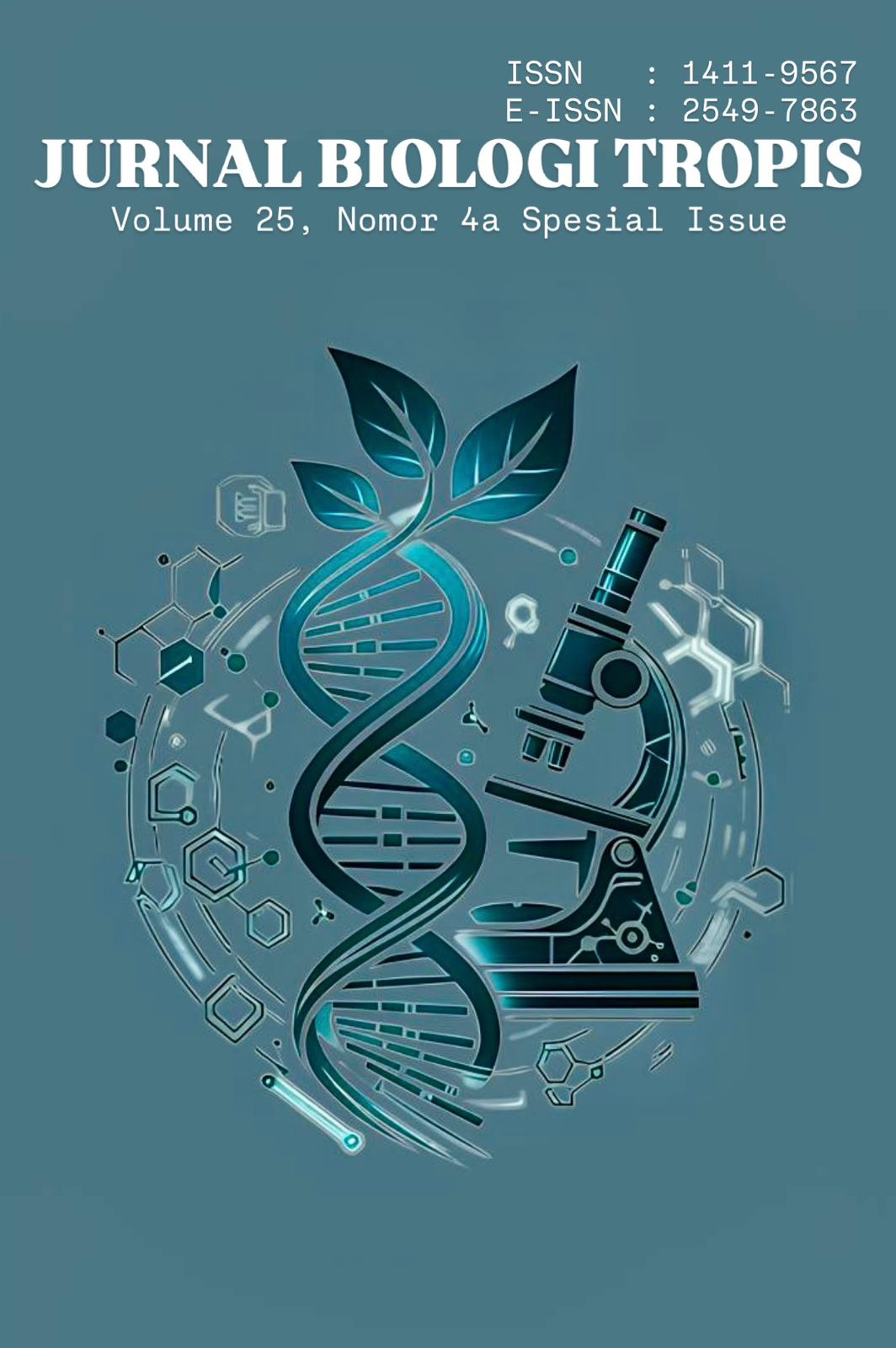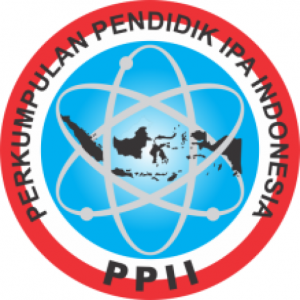Formulation and Physical Evaluation of Ointment Containing Ageratum conyzoides L. Leaf Extract as a Herbal Medicine
Authors
Senfia Liberti Mailani , Titin Sulastri , Marvel Reuben SuwitonoDOI:
10.29303/jbt.v25i4a.10687Published:
2025-11-19Issue:
Vol. 25 No. 4a (2025): Special IssueKeywords:
Ageratum conyzoides L., Babadotan leaves, Herbal ointmentArticles
Downloads
How to Cite
Downloads
Abstract
Babadotan leaves (Ageratum conyzoides L.) are a plant that has long been used in traditional medicine due to their anti-inflammatory, antibacterial, and wound healing properties. This study aims to formulate and evaluate ointment preparations containing babadotan leaf extract as a herbal medicine. This study used a descriptive method in the laboratory and described the tests obtained. The extract was obtained through maceration using 96% ethanol solvent. Formulation evaluation included organoleptic tests, homogeneity, pH, spreadability, adhesiveness, and viscosity. The results showed that formulations F1, F2, and F3 were yellowish green with a distinctive smell of babadotan leaves and were solid because they contained thick babadotan leaf extract. All ointment formulations had homogeneous properties, indicated by the absence of coarse grains in the ointment. The spreadability of formulas F2 and F3 met the criteria, while F1's spreadability was slightly below the lower limit. All three formulas had higher adhesiveness than the standard. The pH values of F2 and F3 were within normal limits and safe to use, while F1 was slightly more alkaline but still acceptable for topical use. All formulas were within the appropriate range for ointments, namely 2,000–50,000 cp. In conclusion, the ointment formulation based on babadotan leaf extract has the potential to be an effective herbal remedy and can be further developed in the pharmaceutical field.
References
Adiyasa, M. R., & Meiyanti, M. (2021). Pemanfaatan obat tradisional di Indonesia: distribusi dan faktor demografis yang berpengaruh. Jurnal Biomedika Dan Kesehatan, 4(3), 130-138. https://doi.org/10.18051/JBiomedKes.2021.v4.130-138
Aini, D. M., & Saputra, F. A. (2025). Sosialisasi Pembuatan Ekstrak Babadotan (Ageratum Conyzoides) sebagai Biopestisida Alami Kepada Kelompok Tani Kelurahan Monjok. Sahaya: Jurnal Pengabdian Masyarakat Multidisiplin, 2(1), 79-87.
Djumaati, F. (2018). Formulasi Sediaan Salep Ekstrak Etanol Daunkelor (Moringa oleifera Lamk.) Dan Uji Aktivitas Antibakterinya Terhadap Bakteri Staphylococcus aureus. Pharmacon, 7(1). https://doi.org/10.35799/pha.7.2018.18799
Effendi, F., & Helmina, S. (2017). Efektivitas Penyembuhan Luka Terbuka Pada Kelinci Dari Formulasi Salep Ekstrak Etanol Daun Babadotan (Ageratum conyzoides L.). Jurnal Farmamedika (Pharmamedika Journal), 2(1), 7-16. https://ejournal.sttif.ac.id/index.php/farmamedika/article/view/26
Fahrina, N., Rudy, G. S., & Peran, S. B. (2021). Manfaat vegetasi di bawah tegakan karet (Hevea brasiliensis) pada KHDTK ULM Mandiangin. Jurnal Sylva Scienteae, 4(3), 492-500. https://ppjp.ulm.ac.id/journals/index.php/jss/article/view/3750
Halimatussa’diyah, Sri Helmina, F. E. (2017). Efektivitas Penyembuhan Luka Terbuka Pada Kelinci Dari Formulasi Salep Ekstrak Etanol Daun Babadotan. Jurnal Farmamedika (Pharmamedica Journal), 2(1). Https://Doi.Org/10.47219/Ath.V2i1.26
Harefa, S. K., Zega, U., & Bago, A. S. (2022). Pemanfaatan Daun Bandotan (Ageratum Conyzoides L.) Sebagai Obat Tradisional di Desa Bawoza’ua Kecamatan Telukdalam Kabupaten Nias Selatan. Tunas: Jurnal Pendidikan Biologi, 3(1), 14-24. https://doi.org/10.57094/tunas.v3i1.477
Hernani, Y. (2016). Formulasi Salep Ekstrak Air Tokek (Gekko gecko L.) untuk penyembuhan luka. Media Farmasi Indonesia, 11(2). https://mfi.stifar.ac.id/MFI/article/view/69
Hindun, S., Rantika, N., & Nafsi, A. A. G. (2024, December). Formulasi Sediaan Spray Gel Ekstrak Etanol Daun Bandotan (Ageratum conyzoides L.) Sebagai Antijerawat. In Bakti Tunas Husada Conference Series (Vol. 4, pp. 144-158). https://ejurnal.universitas-bth.ac.id/index.php/conference/article/view/1513
Kawarnidi, T., Septiarini, A. D., & Wardani, T. S. (2022). Formulasi dan evaluasi salep ekstrak daun ketepeng cina (cassia alata L.) dengan basis vaselin album dan cera alba terhadap jamur candida albicans. Jurnal Farmasi Dan Kesehatan Indonesia, 2(1). https://doi.org/10.61179/jfki.v2i1.244
Lahagina, J. C. G., Yamlean, P. V. Y., & Supriati, H. S. (2019). Pengaruh Pembuatan Salep Ekstrak Daun Afrika (Vernonia Amygdalina) Dengan Basis Hidrokarbon Dan Absorbsi Terhadap Penyembuhan Luka Bakar Pada Kelinci (Oryctolagus Cuniculus). Pharmacon, 8(1), 134. Https://Doi.Org/10.35799/Pha.8.2019.29247
Lasut, T. M., Tiwow, G., Tumbel, S., & Karundeng, E. (2019). Uji Stabilitas Fisik Sediaan Salep Ekstrak Etanol Daun Nangka Artocarpus Heterophyllus Lamk. Biofarmasetikal Tropis, 2(1), 63–70. Https://Doi.Org/10.55724/Jbiofartrop.V2i1.40
Lestari, T., Yunianto, B., & Winarso, A. (2017). Evaluasi mutu salep dengan bahan aktif temugiring, kencur dan kunyit. Jurnal Kebidanan dan Kesehatan Tradisional, 2(1), 8-12. https://doi.org/10.37341/jkkt.v2i1.34
Maghfirah, L. (2021). Gambaran penggunaan obat tradisional pada Masyarakat Desa Pulo secara swamedikasi. Jurnal Sains Dan Kesehatan Darussalam, 1(1), 13-13. https://journal.literasisains.id/index.php/sehatmas/article/view/1383
Makanoneng, D. S. D., Suwitono, M. R., & Sulastri, T. (2025). Formulation And Evaluation Of Transdermal Patch From Extract Of Babadotan Leaves. Jurnal Biologi Tropis, 25(2), 1508–1513. Https://Doi.Org/10.29303/Jbt.V25i2.8761
Meida, E., & Rahmatullah, S. (2021). Uji Aktivitas Antibakteri Formulasi Salep Ekstrak Etanol Daun Bandotan (Ageratum conyzoides L.) Terhadap Bakteri Staphylococcus aureus ATCC 25923. In Prosiding Seminar Nasional Kesehatan (Vol. 1, pp. 2269-2277). https://doi.org/10.48144/prosiding.v1i.1049
Meliyaningsih, P., Syarifatunajah, S., Muhammad, G. I., & Amalia, H. (2024). Utilization of weeds babadotan (Ageratum conyzoides L) as medicine plants: Pemanfaatan Tumbuhan Liar Babadotan (Ageratum Conyzoides L.) sebagai Obat Tradisional. Jurnal Aproksimasi, 1(2), 30-37.
Mulyani, Y., Febiani, L., & Yuniarto, A. (2021). Review Artikel tanaman Bandotan (Ageratum conyzoides Linn) sebagai antibakteri, antioksidan dan antiinflamasi. Praeparandi: Jurnal Farmasi dan Sains, 5(1), 1-19.
Rizga Nurul Aulia, & Sriwidodo. (2022). Sistem Pengantaran Ekstrak Herbal Dalam Formulasi Dan Aplikasi Biomedis. Majalah Farmasetika, 7 (5) 2022, 424-458, 7. https://doi.org/10.24198/mfarmasetika.v7i4.39613
Sandi, D. A. D., & Musfirah, Y. (2018). Pengaruh Basis Salep Hidrokarbon Dan Basis Salep Serap Terhadap Formulasi Salep Sarang Burung Walet Putih (Aerodramus Fuciphagus). Jurnal Ilmiah Manuntung, 4(2), 149–155. Https://Doi.Org/10.51352/Jim.V4i2.194
Sarumpaet, I. R., Sulastri, T., & Suwitono, M. R. (2025). The Preparation And Formulation Of Moringa Oleifera Lam. Leaf Extract In Transdermal Patch.
Sulastri, T., Sunyoto, M., Suwitono, M. R., & Levita, J. (2022). The Effect Of Red Ginger Bread Consumption On The Physiological Parameters Of Healthy Subjects. Journal Of Advanced Pharmacy Education And Research, 12(3), 28–35. https://doi.org/10.51847/mznq1HW7vK
Suliasih, B. A., & Mun’im, A. (2022). Potensi dan Masalah dalam Pengembangan Kemandirian Bahan Baku Obat Tradisional di Indonesia. Chemistry and Materials, 1(1), 28-33. 10.56425/cma.v1i1.22
License
Copyright (c) 2025 Senfia Liberti Mailani, Titin Sulastri, Marvel Reuben Suwitono

This work is licensed under a Creative Commons Attribution 4.0 International License.

Jurnal Biologi Tropis is licensed under a Creative Commons Attribution 4.0 International License.
The copyright of the received article shall be assigned to the author as the owner of the paper. The intended copyright includes the right to publish the article in various forms (including reprints). The journal maintains the publishing rights to the published articles.
Authors are permitted to disseminate published articles by sharing the link/DOI of the article at the journal. Authors are allowed to use their articles for any legal purposes deemed necessary without written permission from the journal with an acknowledgment of initial publication to this journal.


























